使用Assimp进行OpenGL(GLSL)中的骨骼动画
我正在尝试在程序中实现基于GLSL的骨架动画......而不是漂亮的3D动画,我创造了一个怪物:https://i.imgur.com/dmpKg6n.gif
在尝试了几种不同的技巧后,我创造了一个不那么可怕但仍然可怕的事物:

模特是西装中的基本人物,动画应该是腿部摆动而其他所有人都保持不动(一个非常简单的测试动画)。 所有骨骼在原始位置都有t = 0的静态关键帧,以尽量减少它们每隔几秒就跳出一个位置。
问题......应该是相当明显的。而且,我很确定这个模型比它应该的高。
无论如何,这是我最初的Vertex Shader:
#version 430 core
layout (location = 0) in vec4 position;
layout (location = 1) in vec3 normal;
layout (location = 2) in vec2 texcoords;
layout (location = 3) in vec4 color;
layout (location = 4) in vec4 Weights;
layout (location = 5) in vec4 BoneID;
layout (location = 0) out vec4 f_position;
layout (location = 1) out vec3 f_normal;
layout (location = 2) out vec2 f_texcoord;
const int MAX_BONES = 50;
layout (location = 1) uniform mat4 proj_matrix;
layout (location = 2) uniform mat4 mv_matrix;
layout (location = 6) uniform mat4 boneTrans[MAX_BONES];
void main(void)
{
mat4 boneTransform = (boneTrans[int(BoneID[0])] * Weights[0]) +
(boneTrans[int(BoneID[1])] * Weights[1]) +
(boneTrans[int(BoneID[2])] * Weights[2]) +
(boneTrans[int(BoneID[3])] * Weights[3]);
float rem = 1 - (Weights[0] + Weights[1] + Weights[2] + Weights[3]);
boneTransform += mat4(1.0) * rem;
f_texcoord = texcoords;
f_position = mv_matrix * (boneTransform * position);
mat4 mv_mat_simple = mv_matrix;
mv_mat_simple[3][0] = 0.0;
mv_mat_simple[3][1] = 0.0;
mv_mat_simple[3][2] = 0.0;
vec4 norm1 = boneTransform * vec4(normal, 1.0);
vec4 nnormal = mv_mat_simple * vec4(norm1.xyz, 1.0);
f_normal = nnormal.xyz / nnormal.w; // TODO: Normalize?
vec4 pos1 = boneTransform * position;
gl_Position = proj_matrix * mv_matrix * vec4(pos1.xyz, 1.0);
}
这是我的新人:
#version 430 core
layout (location = 0) in vec3 position;
layout (location = 1) in vec3 normal;
layout (location = 2) in vec2 texcoords;
layout (location = 3) in vec4 color;
layout (location = 4) in vec4 Weights;
layout (location = 5) in vec4 BoneID;
layout (location = 0) out vec4 f_position;
layout (location = 1) out vec3 f_normal;
layout (location = 2) out vec2 f_texcoord;
const int MAX_BONES = 50;
layout (location = 1) uniform mat4 proj_matrix;
layout (location = 2) uniform mat4 mv_matrix;
layout (location = 6) uniform mat4 boneTrans[MAX_BONES];
void main(void)
{
vec4 pos1 = vec4(position, 1.0);
pos1 += (boneTrans[int(BoneID[0])] * vec4(position, 0.0)) * Weights[0];
pos1 += (boneTrans[int(BoneID[1])] * vec4(position, 0.0)) * Weights[1];
pos1 += (boneTrans[int(BoneID[2])] * vec4(position, 0.0)) * Weights[2];
pos1 += (boneTrans[int(BoneID[3])] * vec4(position, 0.0)) * Weights[3];
vec4 norm1 = vec4(normal, 1.0);
norm1 += (boneTrans[int(BoneID[0])] * vec4(normal, 0.0)) * Weights[0];
norm1 += (boneTrans[int(BoneID[1])] * vec4(normal, 0.0)) * Weights[1];
norm1 += (boneTrans[int(BoneID[2])] * vec4(normal, 0.0)) * Weights[2];
norm1 += (boneTrans[int(BoneID[3])] * vec4(normal, 0.0)) * Weights[3];
f_texcoord = texcoords;
f_position = mv_matrix * vec4(pos1.xyz, 1.0);
mat4 mv_mat_simple = mv_matrix;
mv_mat_simple[3][0] = 0.0;
mv_mat_simple[3][1] = 0.0;
mv_mat_simple[3][2] = 0.0;
//vec4 norm1 = boneTransform * vec4(normal, 1.0);
vec4 nnormal = mv_mat_simple * vec4(norm1.xyz, 1.0);
f_normal = nnormal.xyz / nnormal.w; // TODO: Normalize?
gl_Position = proj_matrix * mv_matrix * vec4(pos1.xyz, 1.0);
}
骨骼处理代码既不漂亮也不简短:http://pastebin.com/A8x1GdUw
该代码和原始着色器源自http://ogldev.atspace.co.uk/www/tutorial38/tutorial38.html
新的着色器是随机搜索来源的。
编辑:我现在知道了: 
使用以下代码:http://pastebin.com/PvCWUdJn
现在......我做错了什么?!处理这个问题的“正确”方法是什么?我应该使用哪些更高质量的教程代替这个教程吗?
更新:测试应用程序的完整源代码:https://github.com/mcmonkey4eva/skeletalanimationtest
1 个答案:
答案 0 :(得分:1)
所以答案很简单 - 不要在着色器中将矩阵x向量,多个向量x矩阵相乘。
相关问题
最新问题
- 我写了这段代码,但我无法理解我的错误
- 我无法从一个代码实例的列表中删除 None 值,但我可以在另一个实例中。为什么它适用于一个细分市场而不适用于另一个细分市场?
- 是否有可能使 loadstring 不可能等于打印?卢阿
- java中的random.expovariate()
- Appscript 通过会议在 Google 日历中发送电子邮件和创建活动
- 为什么我的 Onclick 箭头功能在 React 中不起作用?
- 在此代码中是否有使用“this”的替代方法?
- 在 SQL Server 和 PostgreSQL 上查询,我如何从第一个表获得第二个表的可视化
- 每千个数字得到
- 更新了城市边界 KML 文件的来源?